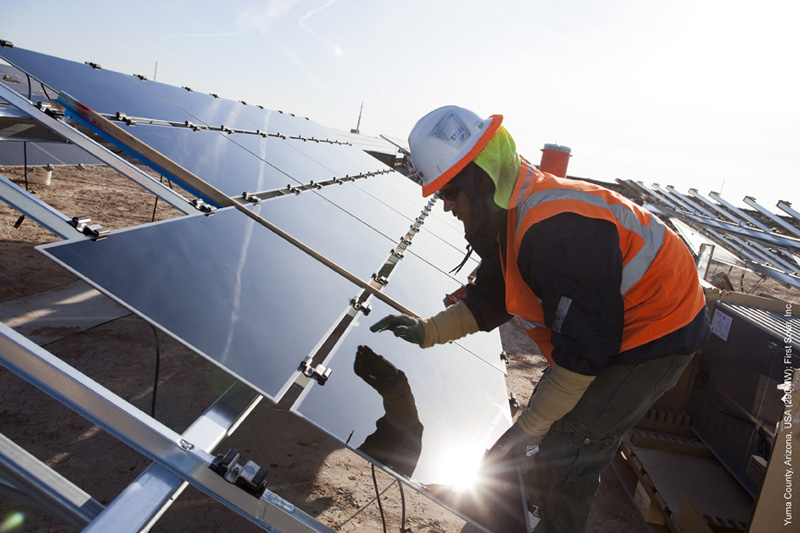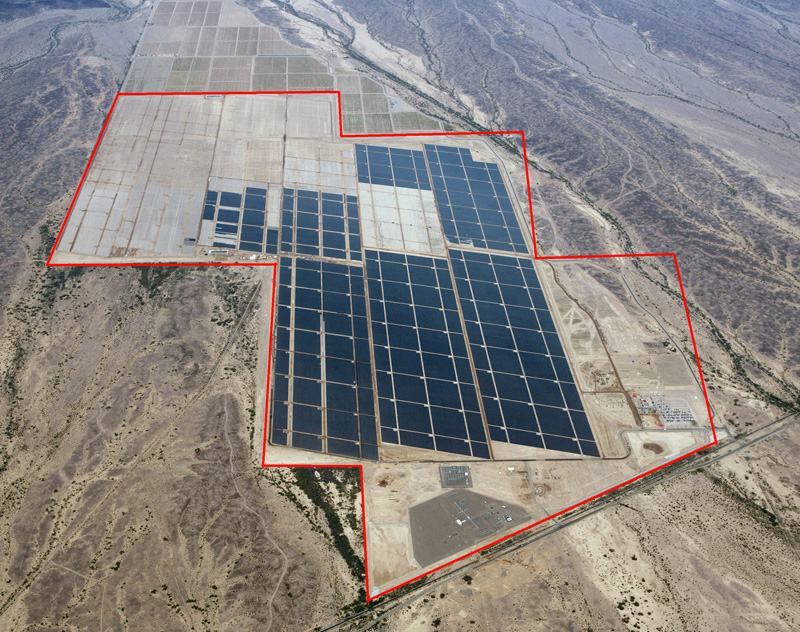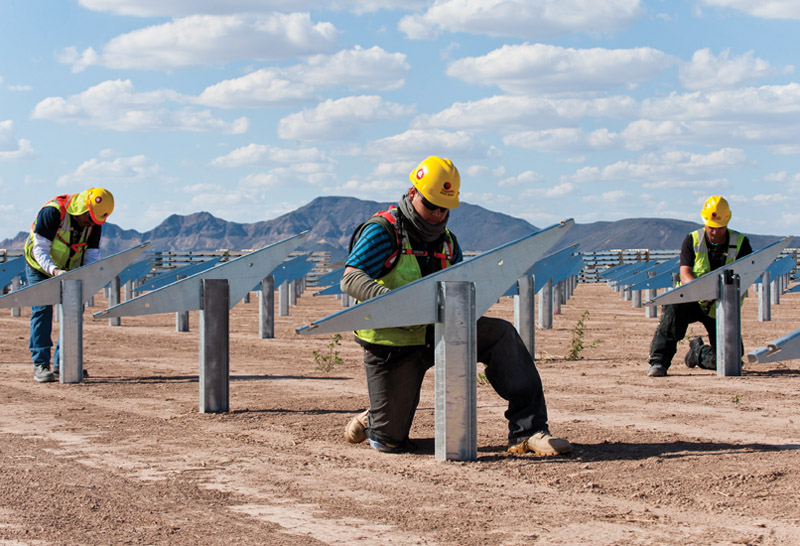Back Issues
Massive Solar MegawattsWork has now been completed on the first phase of the massive 290 MW Agua Caliente solar project in Arizona which, when fully complete, will be the largest PV project in the world. By
Vicky Boyd
Those concepts are now being put to the test with the 290 megawatt Agua Caliente project currently under construction near Dateland, Arizona, about 65 miles east of Yuma. When fully complete and online in early 2014, Agua Caliente will be the largest PV project in the world. "One of the things that First Solar has done over the past four years in the Engineering, Procurement, and Construction (EPC) division is plan for a project like this," said Justin Bloch, First Solar project director in Tempe. "We built smaller projects and practiced the small-scale type installation. Once you perfect that 1 to 1.5 MW array, you can up-size that to be any size of plant." But the No. 1 title will be short-lived as First Solar has two massive 550 MW projects in the pipeline—the Topaz Solar Farm in eastern San Luis Obispo County, California, and the Desert Sunlight Solar Farm in Riverside County, California—that will eclipse Agua Caliente. NextLight Renewable Power LLC of San Francisco began initial work on the Agua Caliente project, which is located on about 2,400 acres of former farmland. Water rights to the land had been sold and the land retired from farming. A major feature is that the Agua Caliente site had the existing Hassayampa-North Gila 500 kilovolt transmission line adjacent to it. In September 2009, the Arizona Corporation Commission unanimously approved Agua Caliente and issued a certificate of environmental compatibility. First Solar became involved in July 2010, when it acquired NextLight and its 1.1 gigawatts of projects in the pipeline. Shortly after that, the California Public Utilities Commission approved a 25-year Power Purchase Agreement (PPA) between San Francisco-based Pacific Gas &Electric Co. and Agua Caliente Solar LLC. First Solar continued development of the project. About the time the firm was moving heavily into the construction phase, NRG Energy Inc. of Princeton, New Jersey, acquired the project in August 2011, Bloch said. Under the arrangement, First Solar remained as the EPC contractor. Once the project is completed, First Solar will also perform operations and maintenance for the next 25 years, he said. Not only was the project's sheer size attractive to NRG, it also had several other attributes, said Randy Hickok, vice president of asset management for NRG's solar subsidiary in Carlsbad, California. "We liked the size and location, and we liked its technology," Hickok said. "As far as solar insolation, it's hard to do better than where the project is located, and obviously that is what makes it a strong project.
The choice of more than 400 Sunny Central 720CP inverters from MA America LLC in Rocklin, California, was also a selling point, Hickok said. The inverters are designed for large, open-field PV plants and designed to withstand temperatures up to 122 degrees Fahrenheit, or 50 degrees Celsius, according to SMA information. "What's novel about this project is primarily the inverters—it's an evolutionary step, not a revolutionary step," he said. Inverter technology is pretty well understood, Hickok said. What's different about the SMA unit is its ability to provide grid stability. If there's a momentary surge in the current, most other inverters would disconnect the facility from the grid. The SMA inverter can keep the plant connected during voltage and frequency excursions and produce power at the prior level once the disturbance is cleared. The system can also monitor grid voltage and automatically adjust the plant's reactive power output to help maintain grid voltage within prescribed bands. Such a large alternative energy project carries a big price tag. In August 2011, the Department of Energy approved a $967 million loan guarantee for Agua Caliente, which was "very, very important," Hickok said. "Projects of this scale are obviously capital intensive," he said. "Given the economic climate at the time that all of this was in the works, private financing wasn't available on that scale." In January, MidAmerican Solar LLC of Phoenix, a subsidiary of MidAmerican Renewables LLC, acquired a 49 percent stake in the $1.8 billion Agua Caliente project as well as First Solar's Topaz Solar Farm. Bloch attributed the project's success to date to First Solar's integrated approach. "It's about having the right team in place, from the engineering team that starts out all the way through to our construction team that builds it," Bloch says. That also includes the procurement team, which lines up material suppliers and fabricators. At the same time, the logistics department plans out just-in-time material deliveries. Most of the project's five million or so thin-film panels are from First Solar's Perrysburg, Ohio, plant; however, smaller supplies are being sourced from First Solar's plants in Malaysia and Germany. Bloch said the project also used 50,000 tons of steel for posts, tilt bracket mounts, and tables. Agua Caliente is only one of several large-scale PV projects First Solar has going. One of the procurement team's responsibilities is to secure alternate material sources should a supplier have problems delivering on time. "When you have the work force there, you don't want people without materials," Bloch says. The materials are delivered to the site by truck or rail. From there, the construction team takes over.
|











